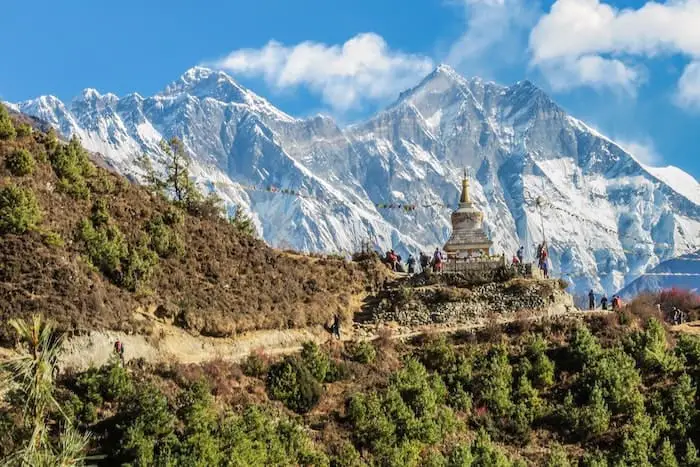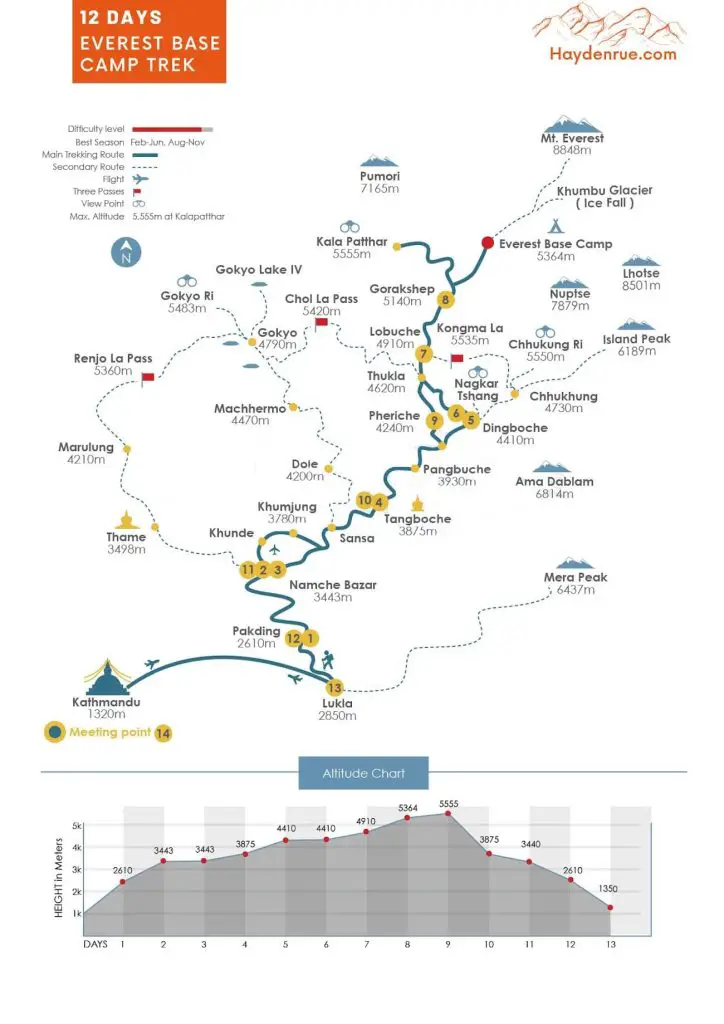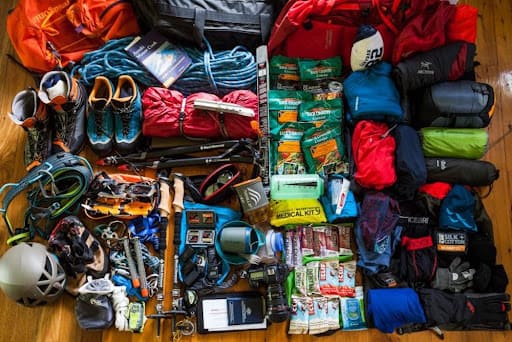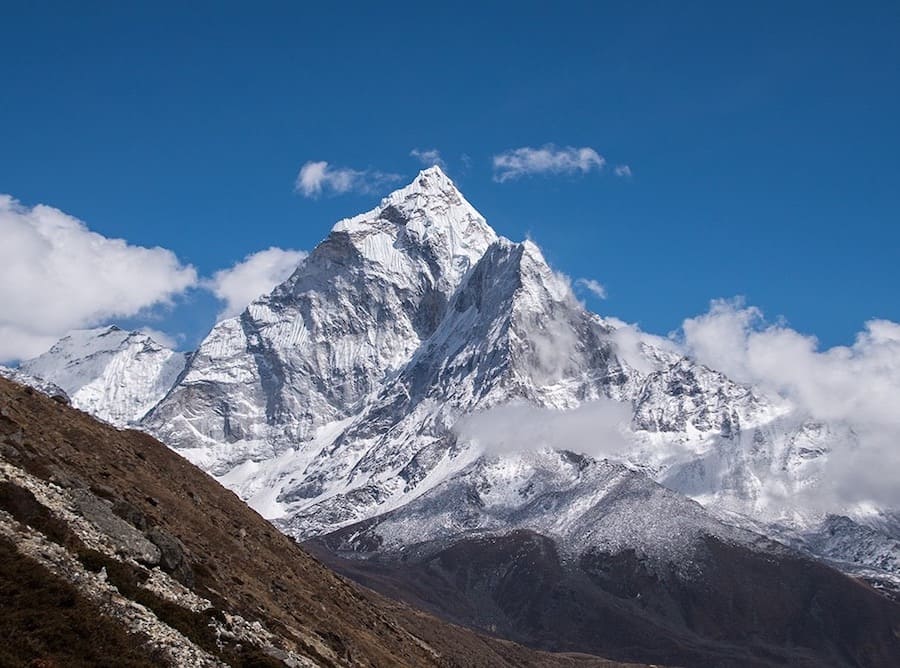The trek to Everest Base Camp (EBC), is a challenging but rewarding experience for the climbers that decide to take on the adventure. Walking the high-altitude terrain on the way to the tallest mountain in the world, is something that you will never forget. However, even though the trek may not require much experience in terms of climbing, it does require a physically fit person to take on the difficult 4-6 hours of walking each day.
Want some more Everest excitement? Check out my top 7 must-watch movies about Everest!
For many, the cost of climbing Everest, or the physical demand of the climb is too great, and they decide to take in the stunning scenery and views of Mount Everest (Sagarmatha) from the base of the giant. However, don’t be fooled, as making the climb to Everest Base Climb is no easy feat!
For my adventurous friends that wish to climb to Everest Base Camp, this guide will provide you insight on everything you will need to know. The topics I will cover in this include:
- The cost of the trek to Everest Base Camp
- The best time to trek to Everest Base Camp
- How long is the trek to Everest Base Camp
- The possibility of trekking to Everest Base Camp without a guide
- Trek to Everest Base Camp route:
- A Everest Base Camp packing list
Let’s jump right into the most important question: Cost of the trek to Everest Base Camp
What is the cost of the trek to Everest Base Camp?
A trek to Everest Base Camp can cost between USD $700 and $2,000. The cheaper option is for independent trekkers with no guide and who are conscious while spending. The more expensive options are going to be with international trekking companies that provide you with luxurious accommodation, facilities and extended routes and stays.
The cost will ultimately depend on the type of experience you want, where you want to stay, and if you want to stay at Everest Base Camp at all. Remember, the closer you get to base camp the more expensive things will cost.
Cost of different types of Everest Base Camp trek options:
The Stingy Nomad has documented their entire trip and budget and have done a good job of breaking down the average cost of different types of Everest Base Camp treks. The cost of each type – guided or independent – can be seen in the table below:
| Everest Base Camp Trek Type | Cost in USD Per person |
|---|---|
| Everest Base Camp Package tour with international agency | $1700 |
| Package tour Everest Base Camp trek with local agency | $1600 |
| Independent Everest Base Camp trek with a guide and porter | $1370 |
| Independent Everest Base Camp trek with a guide | $1085 |
| Independent Everest Base Camp trek with a porter | $930 |
| Everest Base Camp Trek completely independent | $645 |
The best time to trek to Everest Base Camp:

Late September to November, and February to May are the best times to trek to Everest Base Camp (check our Nepali Calendar tool for Nepali dates). These seasons provide the best trekking conditions with low chances of rain, clear skies and good temperatures. However, the opportune weather conditions result in the EBC trek being its busiest, with many of the tea houses and hotels being full.
Best trekking season alternatives:
If you are not a fan of the crowded trekking routes, you have two possible options to avoid all the climbers. One is to take an alternative route that is less traveled. The second option is to try and complete the trek during the winter months, or offseason. That being said, it is not opportune to travel during the winter season as the temperatures get much colder, and some of the tea houses and shops may be closed.
However, if freezing temperatures, and limited places to stay are not a problem for you, the winter season offers crystal clear skies and spectacular views of the mountains. Additionally, during the offseason you can look to save money on rooms, food and even trekking companies and services, as there won’t be as much business and trekkers during this time.
How long is the trek to Everest Base Camp?
Starting and finishing in Kathmandu, Everest Base Camp trek will take 12 days and 130 km of hiking to complete. The 12 day trek includes an 8 day climb and 4 days for descent, with one rest day in Namche Bazaar and an acclimatization hike to Chhukung Valley.
Trek to Everest Base Camp Itinerary:
Although a standard EBC trek will take 12 days, it can be extended as well, depending on if you want to stay longer in certain areas, like base camp. However, I strongly recommend against shortening the trek as you may run into issues with high altitude sickness.
A basic itinerary for the EBC trek usually looks something like this:
| Starting Location | Ending Location | Maximum Altitude | Trek Distance | Trekking Duration |
|---|---|---|---|---|
| Flight from Kathmandu to Lukla | Phakding | 2,650m / 8,562ft | 6.2km / 3.8 miles | 3 hours |
| Phakding | Namche Bazaar | 3,440m / 11,285ft | 7.4km / 4.6 miles | 6 hours |
| Rest Day/Acclimation | ||||
| Namche Bazaar | Tengboche/ Deboche | 3,855m / 12,850ft | 9.2km / 5.7 miles | 5 hours |
| Tengboche | Dingboche | 4,360m / 14,290ft | 12km / 7.45 miles | 5 hours |
| Rest Day/Acclimation | ||||
| Dingboche | Lobuche | 4,930m /16,175ft. | 8.5km / 5.2 miles | 5 hours |
| Lobuche | Everest Base Camp and back to Gorak Shep | 5,364m / 17,598ft | 15km / 9.32 miles | 6-8 hours |
| Gorak Shep | Hike to Kala Patthar viewpoint, trek to Gorak Shep then to Pheriche | 5,555m / 18,208ft | 9.6km / 6 miles | 5 hours |
| Pheriche | Tengboche | 4,250m / 13,945ft | 8.5km / 5.2 miles | 4-5 hours |
| Tengboche | Namche Bazaar | 3,855m / 12,850ft | 9.2km / 5.7 miles | 5 hours |
| Namche Bazaar | Phakding | 3,440m / 11,285ft | 7.4km / 4.5 miles | 4 hours |
| Phakding | Lukla | 2,850m / 9,350ft | 6.2km / 3.8 miles | 3-4 hours |
| Lukla | Fly back to Kathmandu | 2,850m / 9,350ft | N/A | 40 minute flight |
The table above shows a standard 12 day trekking experience to Everest Base Camp. As mentioned above, you can extend your trip and stay a few extra days in different places that you like. Or you can look to take alternative routes, check out monasteries, or partake in different festivals during the year.
It is important to note that if you are working with a trekking agency, it will be best to discuss all of this before you leave for your trip so they can plan accordingly, and ensure everything is in order.
Trek to Everest Base Camp route:
As mentioned there are multiple routes and side treks that you can take while you are trekking to Everest Base Camp. Below is an image showcasing the locations on the itinerary mentioned in the section above. Moreover, it highlights some other notable locations that can be added to your Everest Base Camp trek as well.

Is it possible to do Everest Base Camp without a guide?
Previously, yes, you could do it without a guide. However, as of April 2023, the government of Nepal has made it mandatory for foreign trekkers to be accompanied by a guide.
That being said, the trekking route is easy to follow and there are plenty of people to ask for directions and help during the trek. Moreover, don’t forget that you will also have to get trekking insurance while trekking to Everest Base Camp. Check out my round up of best trekking insurance to find out which insurance provider is best for you!
When it comes to getting a trekking guide, there is never short of options. So make sure you find the right guide, or trekking company to work with for your trip. Whereas depending on the guide and their level of expertise, they may become more of a hindrance than a support. However, on the other hand, you can get a highly professional guide who can save you a lot of money and time on your Everest Base Camp trek.
It ultimately comes down to what type of experience and the level of support you are looking for during your adventure. So make sure you do your research and read reviews before deciding on a guide or company to go with.
In this regard, I will list out some pros and cons to trekking with a guide and without a guide:
Pros of trekking EBC without a guide:
- Going without a guide or porter is by far the cheapest way to trek to Everest Base Camp
- You can go at your own pace.
- Are able to choose your own hotels, places to eat at and places to see and visit.
- Can help reduce chances of high altitude sickness as you can go at your own pace and take as many rest days as needed, without feeling rushed or time bound.
- You will be forced to do your own research on all things related to the trek, giving you a better insight into the history, culture, and people of the Everest Region. Also, you will more than likely get to talk to more local people along the trek. (This may not be a positive for everyone, but I enjoy doing my own research and talking to as many people as possible!)
Cons of trekking Everest Base Camp without a guide:
- If you sustain an injury or some sort of emergency you will have to deal with it by yourself, in a very remote part of Nepal.
- If you are unaware, or do not have experience with high altitude sickness, you can end up putting yourself in danger.
- At higher altitudes, assistance and help from porters and guides will end up costing you much more than if you booked a guide before
- During the busy trekking season it can be difficult to find lodging by yourself as many hotels get pre-booked by other tour groups.
A Everest Base Camp packing list

In this section I highlight everything you will need to pack to climb to Everest Base Camp. But if you are looking for a more general list of things to pack, check out my Nepal packing list blog!
Depending on your preferences, and how comfortable you are with wearing things multiple times, you can bring more or less. However, it is important to remember that every added item is more weight that you are your porter will have to transport and carry.
EBC Clothing Packing List
- Moisture-wicking long-sleeve t-shirts (2)
- Moisture-wicking short-sleeve t-shirt (1)
- Heavy fleece or down jacket
- Waterproof jacket
- Windbreaker
- Fleece pants
- Trekking pants
- Hiking shorts
- Hiking socks (7)
- Warm thermal socks
- Long underwear (2)
- Underwear (10)
- Hiking boots with ankle support (Check out our 3 best hiking boots for people with flat feet)
- Extra camp shoes
- Insulated wool or down mittens/gloves
- Sunglasses
- Broad-brimmed hat
- Neck gaiter or bandana (for sun protection)
- Wool hat (should cover ears)
Everest Base Camp Trekking Supplies and Gear Packing List
- Duffle bag if you are packing heavy and have porters to carry your supplies
- 40L Daypack for carrying what you need on the trail
- Waterproof cover for daypack
- Water bottle
- Trekking poles
- Headlamp with extra batteries
- Water sterilization method (iodine tablets, small filter, lifestraw)
- Quick-drying trekking towel (optional)
EBC Toiletries Packing List
- Sunscreen
- Lip balm with sunscreen
- Toilet Paper (optional – depending on how comfortable you are using water to clean yourself after the bathroom)
- Ibuprofen
- Diamox (for altitude sickness)
- Antibiotics (Cipro for travelers’ diarrhea)
- Anti-chafe balm (e.g. Body Glide, to prevent chafing)
- Deodorant
- Toothbrush/toothpaste
- Wet wipes
- Hand sanitizer
- Feminine hygiene products (as needed)
- Face lotion
Additional Supplies/Items
- Power bank
- Book
- Journal/pen
- Playing cards
- Trekking Insurance
- Camera
